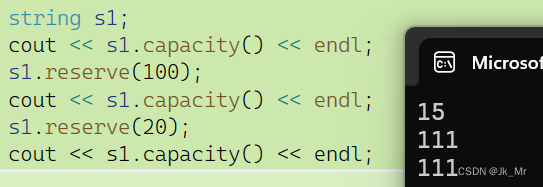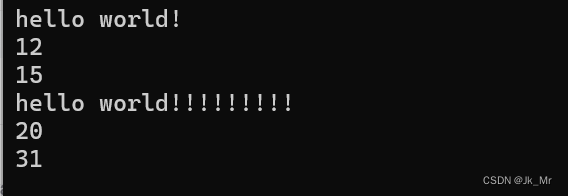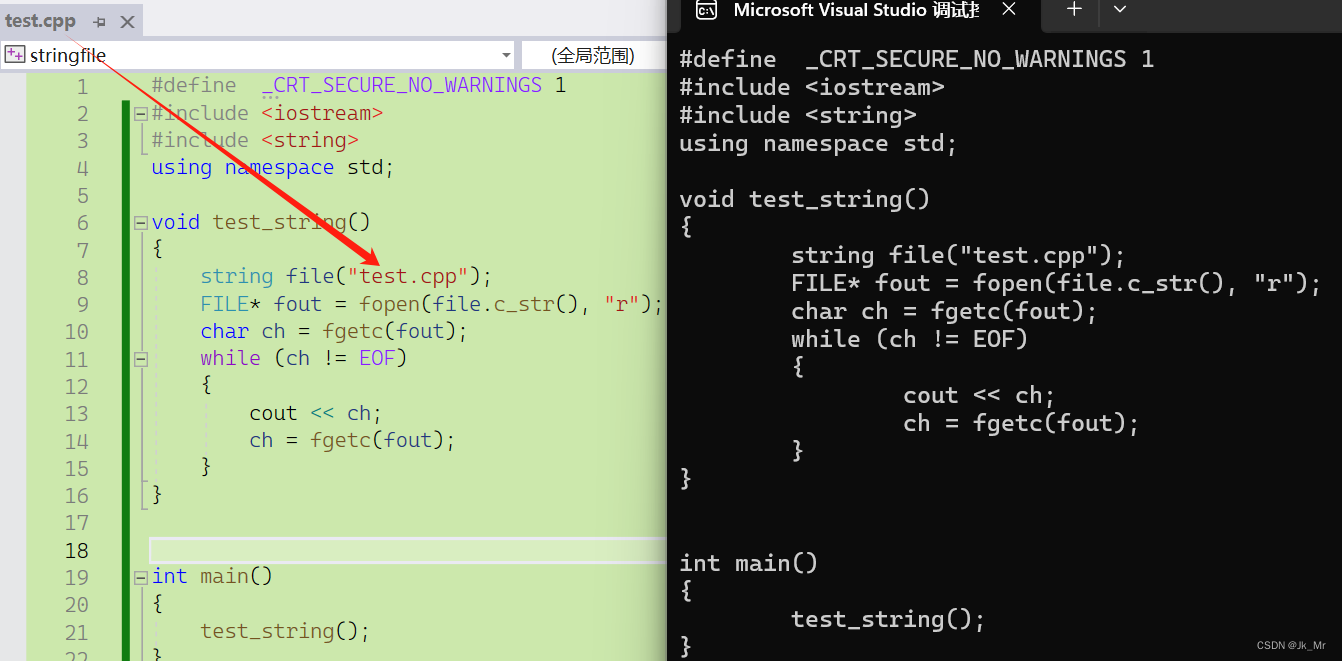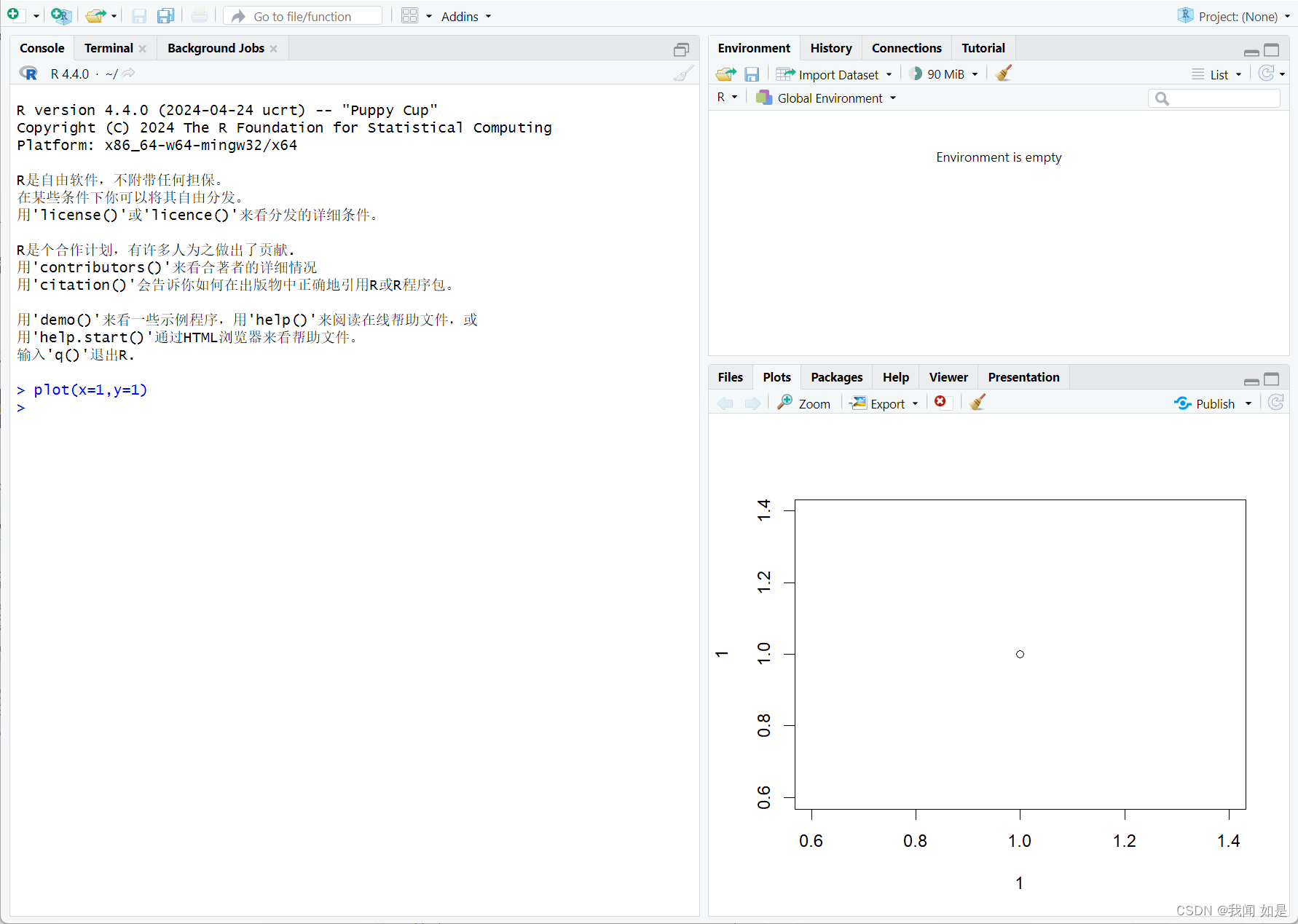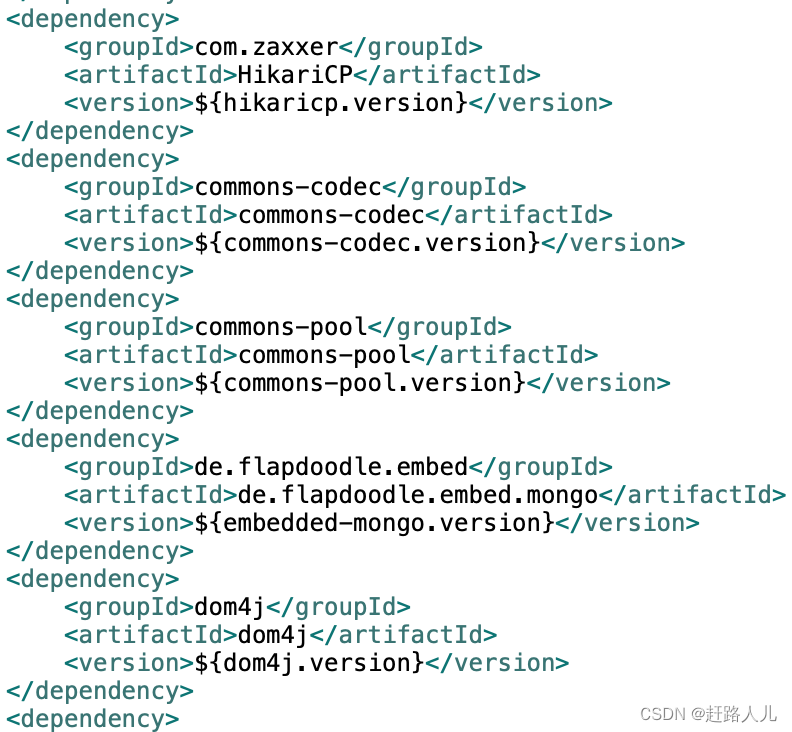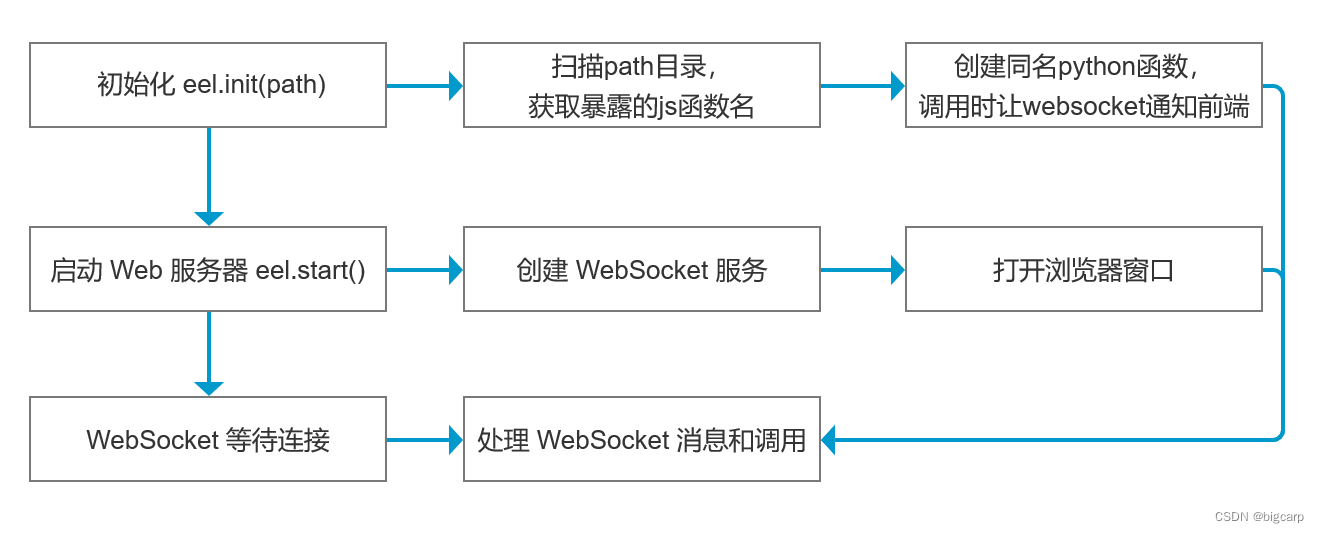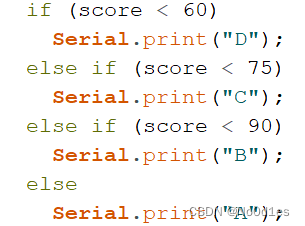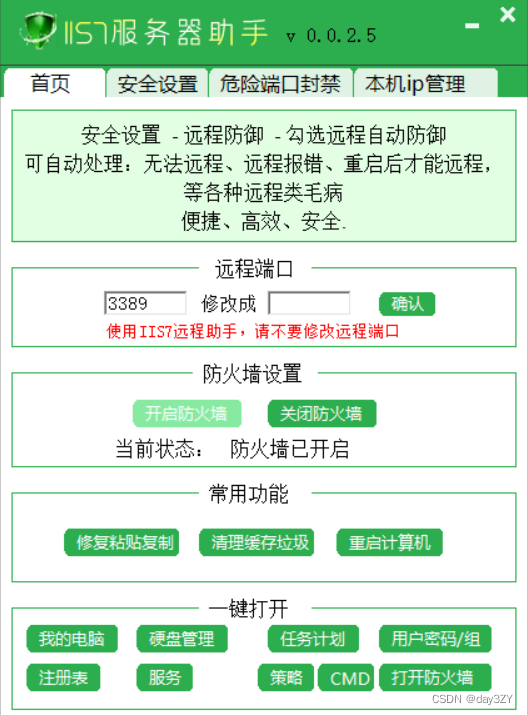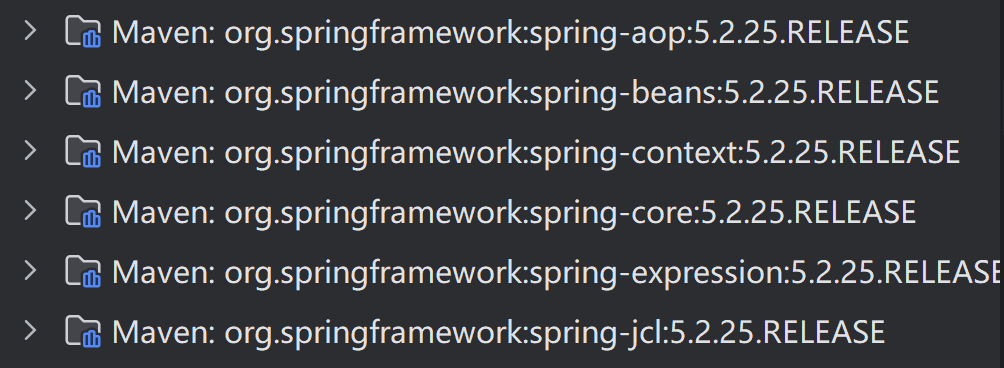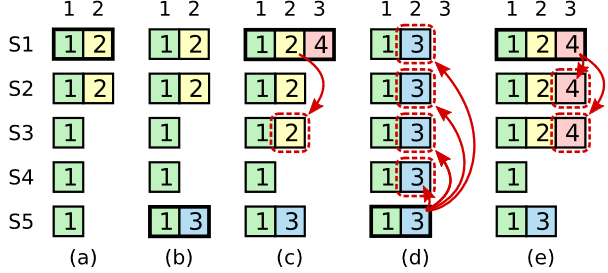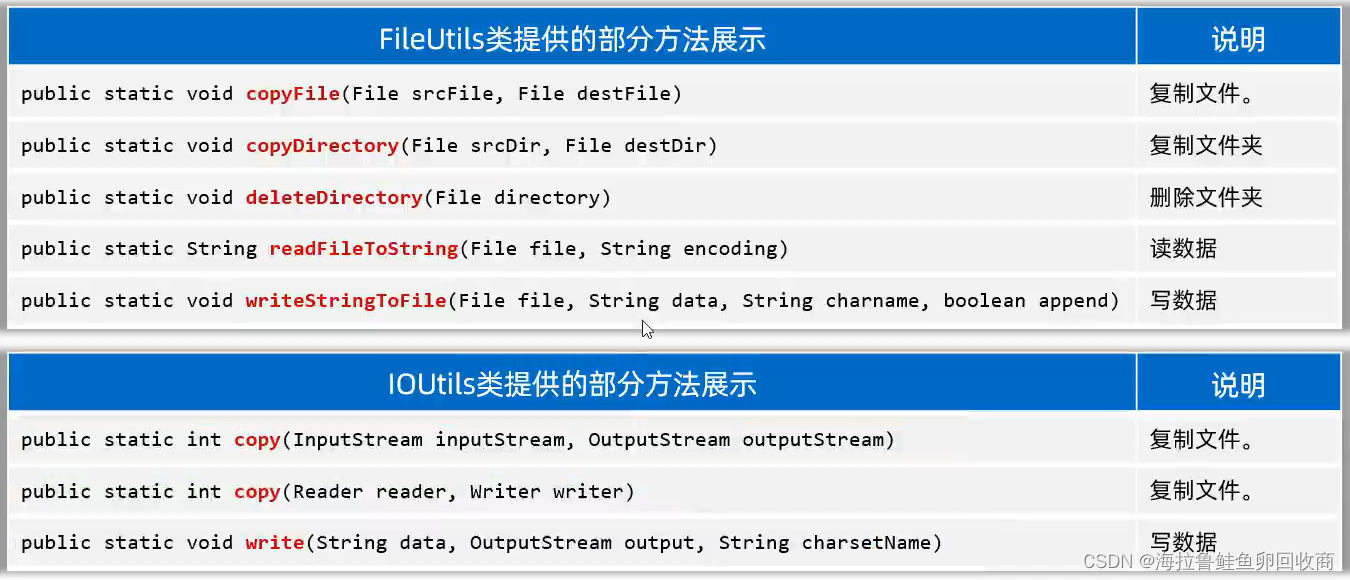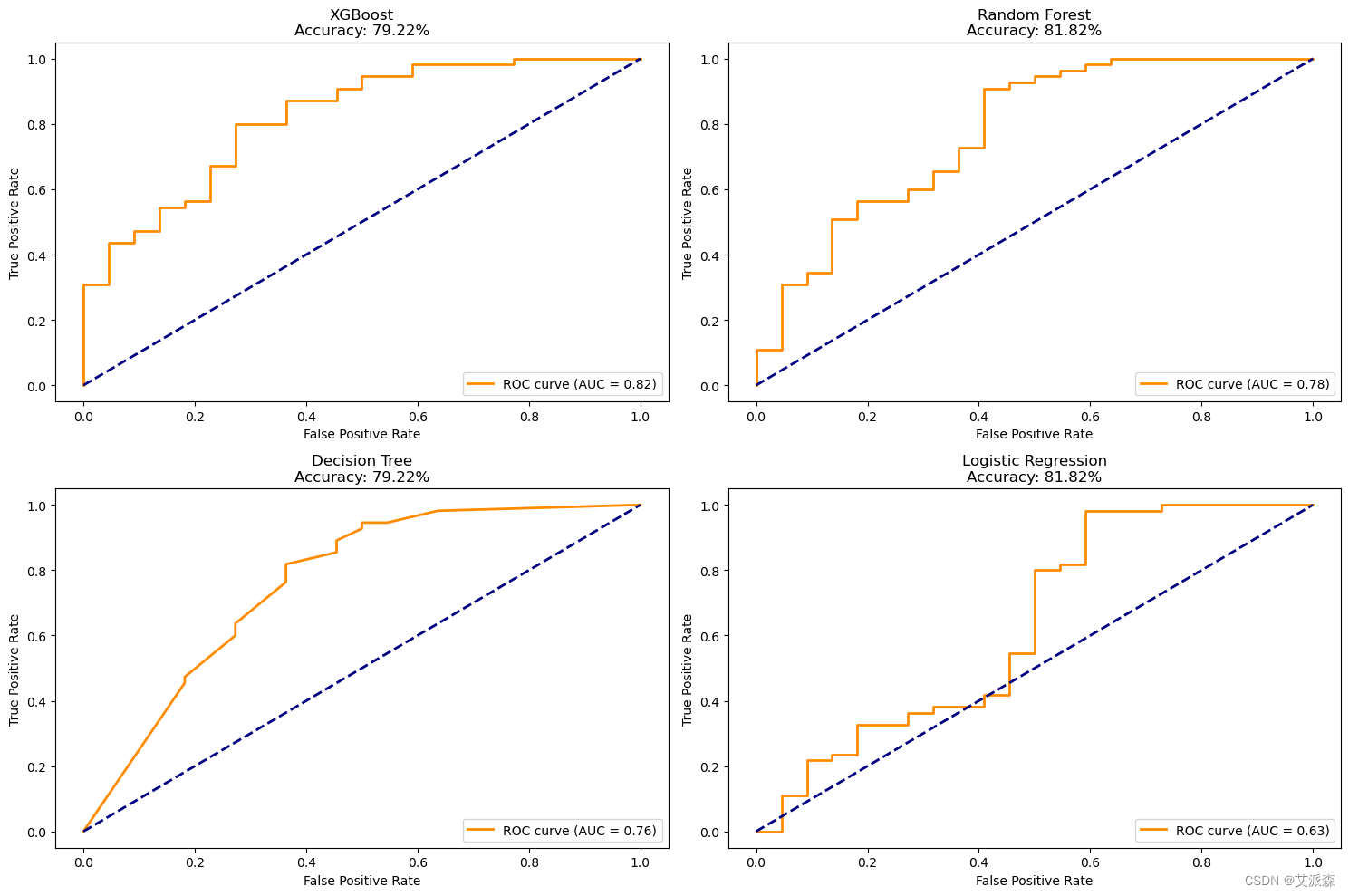系列文章目录
文章目录
目录
系列文章目录
文章目录
前言
一、为什么要学习string
1.c语言的字符串
2.OJ上的使用
二、string类的接口介绍
1.string简介
2.string构造成员函数
3.operator=函数
4.string容器size和length
5.重载operator[]和引用返回的意义
5.1 operator[]
5.2 at访问
5.3.front 和 back
6.迭代器Iterators
范围for遍历
7.反向迭代器iterator
8.插入和修改
8.1 push_back尾插
8.2 append追加
8.3 +=常用编辑
8.4 pop_back和erase
8.5 assign 分配
8.6 insert(重点)
8.7 erase 删除
8.8 replace 替换
8.9 swap交换
9.其他容器(resize,reserve····)
9.1 capacity、max_size
9.2 reserve、resize
1 reserve
2 resize
3 shrink_to_fit
10. 字符串操作
10.1 c_str
10.2 find
rfind的应用:
10.3 find_first_of
10.4 find_last_of
10.5 find_not_first_of和find_not_last_of
10.6 compare
11.非成员函数
11.1 operator+
11.2 relational operator
12.字符串和其他数组类型转换
三、字符串题目:
1.仅仅反转字母
2.字符串中的第一个唯一字符
3.验证回文串
4.字符串相加
5.字符串最后一个单词的长度
6.getline
四、字符排序sort
前言
STL(standard template libaray-标准模板库):是C++标准库的重要组成部分,不仅是一个可复用的组件库,而且是一个包罗数据结构与算法的软件框架。网上有句话说:“不懂STL,不要说你会C++”。STL是C++中的优秀作品,有了它的陪伴,许多底层的数据结构以及算法都不需要自己重新造轮子,站在前人的肩膀上,健步如飞的快速开发。
一、为什么要学习string
1.c语言的字符串
C语言中,字符串是以'\0'结尾的一些字符的集合,为了操作方便,C标准库中提供了一些str系列的库函数,但是这些库函数与字符串是分离开的,不太符合OOP的思想,而且底层空间需要用户自己管理,稍不留神可能还会越界访问。
2.OJ上的使用
在OJ中,有关字符串的题目基本以string类的形式出现,而且在常规工作中,为了简单、方便、快捷,基本都使用string类,很少有人去使用C库中的字符串操作函数。
二、string类的接口介绍
在学习类时离不开接口的查询,所以我们通过文档来介绍string:
string![]() https://legacy.cplusplus.com/reference/string/string/
https://legacy.cplusplus.com/reference/string/string/
1.string简介

string实际上是个类模板basic_string<template>. 这里涉及编码,我们后面在讲解。接下来我们开始介绍接口,将string理解为char类型的顺序表即可。
2.string构造成员函数

构造函数:
我们介绍最常用的几个,分别是(1)(2)(4):
string s1; //(1)
string s2("hello string!");//(4)
string s3(s2); //(2)我们使用cout和cin输出输入string实例化的对象:
#include <iostream>
#include <string>
using namespace std;
void test_string01()
{
string s1;
string s2("hello string!");
string s3(s2);
cout << s1 << endl;
cout << s2 << endl;
cout << s3 << endl;
cin >> s1;
cout << s1 << endl;
}
int main()
{
test_string01();
return 0;
}注意:string的输入和输出是被重载过的所以我们能使用。
![]()
对于这个我们可以猜想,pos时postion(位置)的缩写,是部分拷贝。关于npos我们也可以查找


无符号的整形-1,按照补码储存,整形最大值,由于一个数组开4G不现实,使用npos实际上就是结束位置。所以如果len > 字符长度或者不传时就是npos。
void test_string01()
{
string s1;
string s2("hello string!");
string s3(s2);
string s4(s2, 6);
cout << s4 << endl;
string s5(s2, 6, 12);
cout << s5 << endl;
}结果:
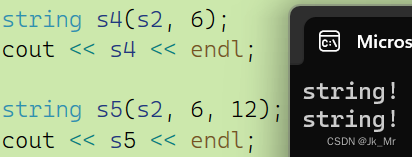
下面这样也可以:
string s6("hello string!", 6, 12);这样实际上是隐式类型转换,字符串"hello string!"构造临时对象,然后通过函数进行构造。
优化后是直接构造:
//构造
string s1("hello string!");
//隐式类型转换
string s2 = "hello string!";
//隐式类型转换有临时对象产生
const string& s3 = "hello string!";C++类和对象(下)-CSDN博客![]() https://blog.csdn.net/Jk_Mr/article/details/138169401?spm=1001.2014.3001.5501上的文章中解释了隐式类型转换。
https://blog.csdn.net/Jk_Mr/article/details/138169401?spm=1001.2014.3001.5501上的文章中解释了隐式类型转换。
![]()
对于(5)查看文档可知,(5)是拷贝字符串"···"的前n个字符。

![]()
对于(6),则是使用n个字符‘’进行构造:

后面几个了解一下。关于(7)涉及迭代器我们后面再将。
3.operator=函数
赋值可以是字符串、字符或者string对象。
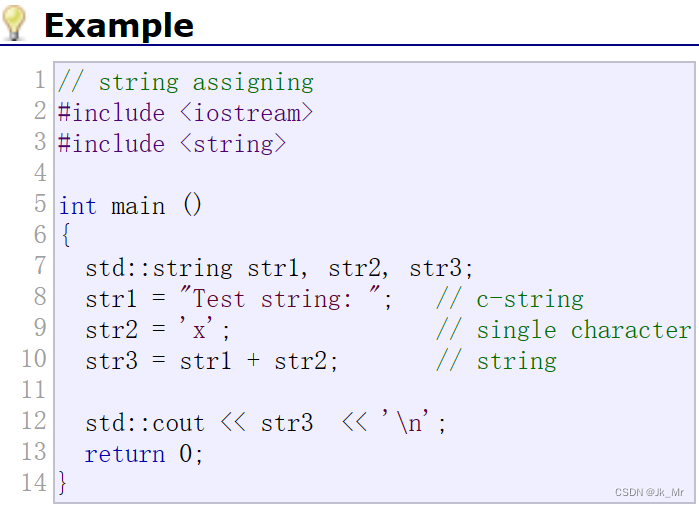
4.string容器size和length
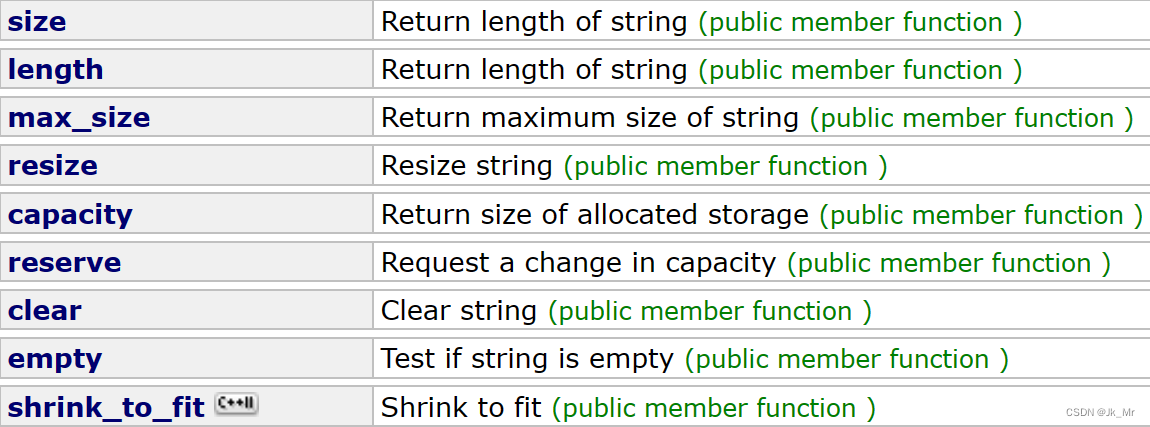
string s1("hello string!\n");
cout << s1.size() << endl;
cout << s1.length() << endl;size和length是一样的。为什么呢?
实际上是因为string比STL出来的更早,当时定义长度的就是length。由于要保持接口一致性所以增加了size。
同样为了兼容c语言,字符串的最后一个实际上是\0.size和length都不计算\0.
5.重载operator[]和引用返回的意义
5.1 operator[]
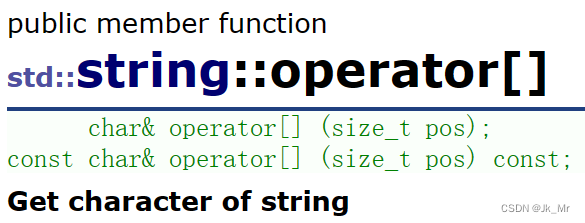
有了这个重载,string就可以像数组一样去使用。它的原理类似于:
class string
{
public:
//引用返回
//1、减少拷贝
//2、修改返回值
char& operator[](size_t i)
{
assert(i < _size);
return _str[i];
}
private:
char* _str;
size_t _size;
size_t _capacity;
};那么就可以像数组一样进行访问:
string s1("hello string!\n");
//可以像数组一样进行访问
for (int i = 0; i < s1.size(); i++)
{
cout << s1[i] << ' ';
}
可以像数组一样进行修改:
//可以进行修改
for (int i = 0; i < s1.size(); i++)
{
s1[i] = 'x';
}
对象开辟的空间在堆上。所以可以进行访问和修改。
并且string越界可以检测,使用的是断言assert。
关于第二个const修饰的operator=()函数,是因为要访问不可修改的对象。

下标[]实际上只有连续的空间能够支持,string、vector(顺序表)。
那么还有别的方式访问string 的内容吗?接下来我们介绍迭代器。
5.2 at访问

和[]的功能是一样的,但是越界访问有区别。operator[]是断言没有商量的余地。
而at是抛异常,可以捕获。(异常后面讲解)
string s1("hello world!");
s1[50];string s1("hello world!");
s1.at(50);
string s1("hello world!");
try {
s1.at(50);
}
catch (const exception& e)
{
cout << e.what() << endl;
}5.3.front 和 back
front是获取首元素,back是尾元素。
6.迭代器Iterators
迭代器通常包含指向容器中某个元素的指针或引用,以及一些操作符(如递增、递减等),用于在容器中移动和访问元素。
先看使用方法:
可以将迭代器理解为指针或者像指针一样的东西(不一定是指针)
string s1("hello string!");
//遍历方式1:下标
for (int i = 0; i < s1.size(); i++)
{
cout << s1[i] << ' ';
}
cout << endl;
//遍历方式2
string::iterator it1 = s1.begin();//iterator需要指定类域
while (it1 != s1.end())
{
cout << *it1 << ' ';
++it1;
}
cout << endl;可以记住这个使用方式,使用typeid可以看变量的类型:
cout << typeid(it1).name() << endl;
所以说不能认为it1是指针,只是用法像指针。
同样迭代器也可以修改内容:
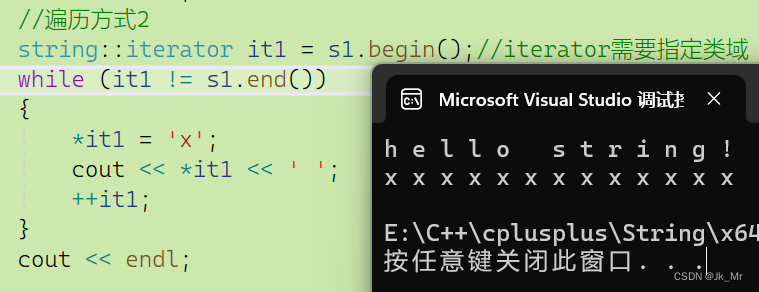
迭代器是通用的,链表list、二叉树都有迭代器。可以观察list 的文档。

范围for遍历
//遍历方式3
for (auto s : s1)
{
cout << s << ' ';
}元素赋值给s,自动往后,自动赋值。

所有的容器都可以使用范围for,本质上它使用的就是迭代器。
注意是赋值拷贝给s所以,不会改变s1的内容: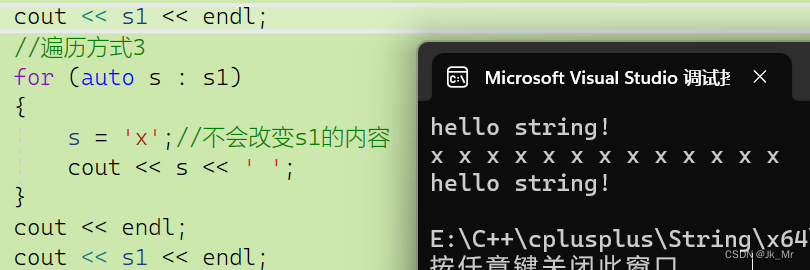
要改变则需要使用引用auto& s:
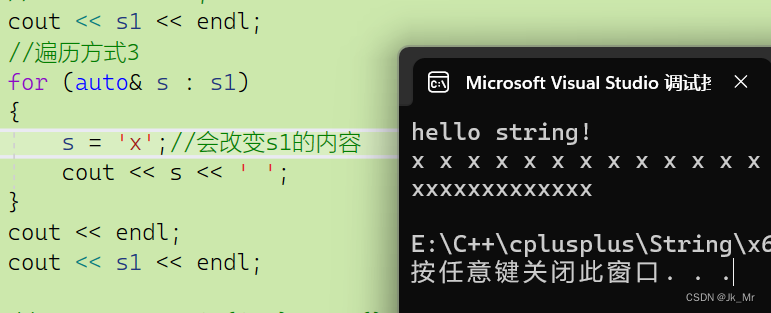
string也实现const迭代器:

即对象是一个const对象,使用非const迭代器可以修改,会报错,所以要使用const迭代器。
iterator是可读可写,const_iterator是只读。不是const iterator,是要保护迭代器指向的内容,而不是保护迭代器本身。

实际上是这里使用auto就不用考虑了,auto根据右边进行推导。
7.反向迭代器iterator
反向迭代器就是从后往前迭代。
它的++是倒着走的。
string s1("hello string!");
auto it1 = s1.begin();
while (it1 != s1.end())
{
cout << *it1 << ' ';
*it1++;
}
cout << endl;
string::reverse_iterator it2 = s1.rbegin();
while (it2 != s1.rend())
{
cout << *it2 << ' ';
*it2++;
}
cout << endl;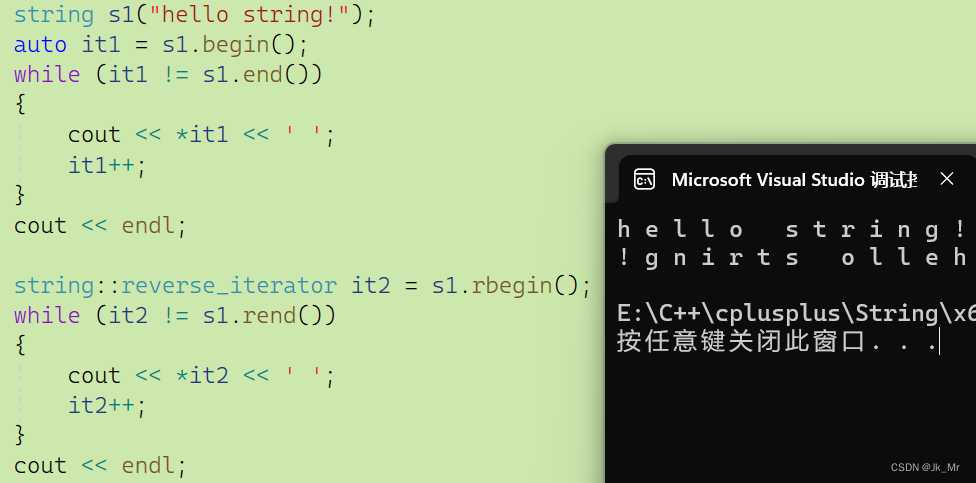
由于string有[]重载,所以比较少用迭代器,但是迭代器是通用的。

这四个实际上可以当作const_iterator迭代器使用。
8.插入和修改
8.1 push_back尾插

push_back()是插入一个字符:
string s;
s.push_back('a');
cout << s << endl;8.2 append追加
append可以尾插一串数据.所有的len是跨度的意思。
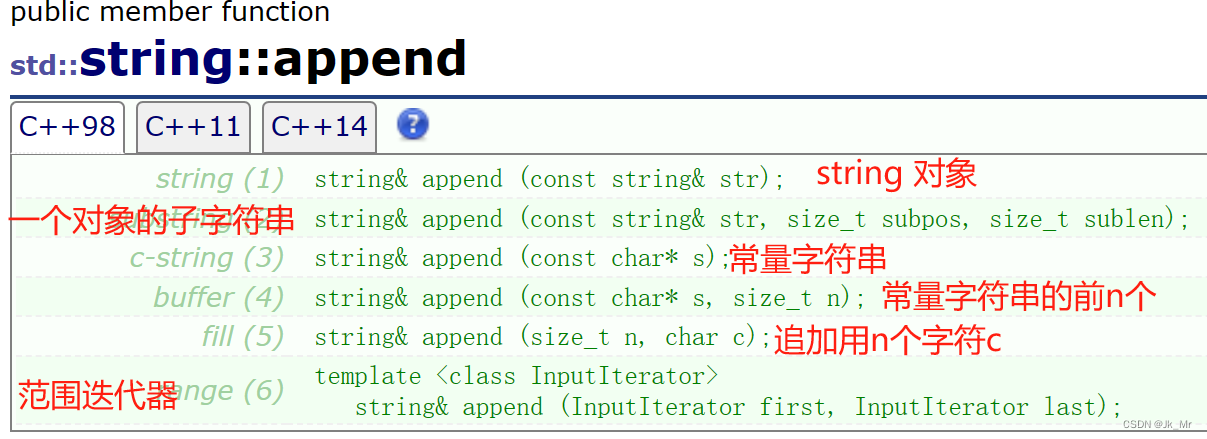
string s1("hello");
string s2(" string");
//追加string对象
s1.append(s2);
cout << s1 << endl;
//追加string对象的子串
s1 = "hello";
//从子串的0位置,跨度为2
s1.append(s2, 0, 2);
cout << s1 << endl;
//追加常量字符串的前n个
s1 = "hello";
s1.append(" strnig",4);
cout << s1 << endl;
//追加n个字符c
s1 = "hello";
s1.append(2,'s');
cout << s1 << endl;
//迭代器
s1 = "hello";
s1.append(s2.begin(),s2.end());
cout << s1 << endl; 结果 :
8.3 +=常用
8.4 pop_back和erase
pop_back()只支持删除一个。
erase则支持删除一段:
8.5 assign 分配
assign实际上和赋值差不多,和append差不多的解释:

8.6 insert(重点)

string s1("hello");
string s2("string ");
//pos位置string对象
s1.insert(0,s2);
cout << s1 << endl;
//pos位置string对象的子串
s1 = "hello";
s1.insert(0, s2, 0,3);
cout << s1 << endl;
//pos位置常量字符串的前n个
s1 = "hello";
s1.insert(0,"strnig ", 4);
cout << s1 << endl;
//pos位置n个字符c
s1 = "hello";
s1.insert(0,2, 's');
cout << s1 << endl;
//迭代器插入n个字符c
s1 = "hello";
s1.insert(s1.begin(), 2, 's');
cout << s1 << endl;
//迭代器
s1 = "hello";
s1.insert(s1.begin(), s2.begin(), s2.end());
cout << s1 << endl;可以用insert头插数据,但是insert进行插入,后面的数据都要后移,使用尽量少用,效率较低。
8.7 erase 删除
删出和insert一样要慎用,因为效率低,需要移动数据。
string s1("hello world!");
cout << s1 << endl;
s1.erase(0, 5);
cout << s1 << endl;
s1 = "hello world!";
s1.erase(s1.begin());
cout << s1 << endl;
s1 = "hello world!";
s1.erase(s1.begin()+5, s1.end());
cout << s1 << endl; 
insert和erase的len都可以传很长,因为有npos缺省,但是第一个位置参数不能超出实际范围。
8.8 replace 替换
有了上面的基础,在观察replace的文档就不难了:
替换从字符位置pos开始并跨越len个字符(或字符串范围[i1,i2)之间的部分)的字符串部分为新内容:注意len是阔度,将长度为len的这一段替换成新的内容str。覆盖并插入。
string s1("hello world!");
string s2("and");
//从5位置开始,跨度为1,即将空格替换成and
s1.replace(5, 1, s2);
cout << s1 << endl;
//从5位置开始,跨度为1,即将空格替换成and
s1 = "hello world!";
s1.replace(s1.begin() + 5, s1.begin() + 6, s2);
cout << s1 << endl;
//将空格替换成%20
s1 = "hello world!";
s1.replace(5, 1, "%20");
cout << s1 << endl;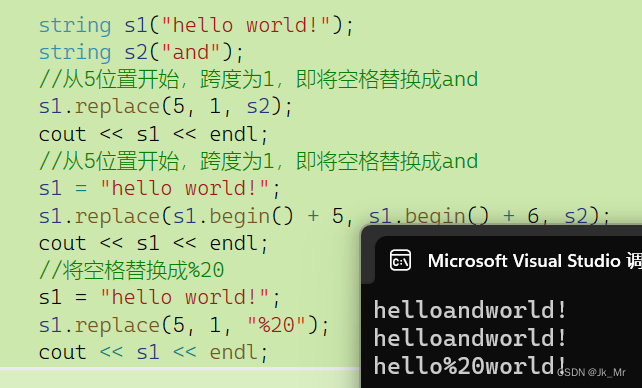
题目:
将字符s1中所有的空格替换成%20:
string s1("hello world! and hello string!");
for (size_t i = 0; i < s1.size();)
{
if (s1[i] == ' ')
{
//替换//跨度为1
s1.replace(i, 1, "%20");
i += strlen("%20");
}
else
i++;
}
cout << s1 << endl;其中也设计数据挪动,效率较低。介绍一种更好的方法:
string s1("hello world! and hello string!");
string s2;//将数据放到另一个对象中
for (auto s : s1)
{
if (s != ' ')//不是空格插入
s2 += s;
else
s2 += "%20";//是空格就插入%20;
}
cout << s2 << endl;
牺牲空间换时间。
8.9 swap交换
交换涉及深拷贝,后面会讲解,这里要会用。
交换成str。
string s1("hello");
string s2("string!");
cout << s1 << endl;
cout << s2 << endl;
s1.swap(s2);
cout << s1 << endl;
cout << s2 << endl;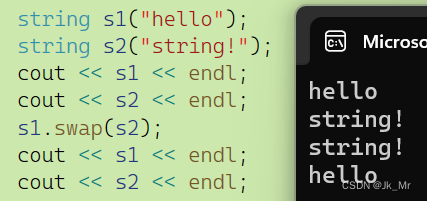
9.其他容器(resize,reserve····)
9.1 capacity、max_size
string s1("hello world!");
cout << s1.size() << endl;
cout << s1.capacity() << endl;
cout << s1.max_size() << endl; 在vs2022(32位下)中实际容量大小和size大小是不一样的.max_size就是string在32位下的最大。 实际上也开不了max_size(),因为开一个字符串就到了2G左右,这么大的连续空间时开不出来的。
实际上也开不了max_size(),因为开一个字符串就到了2G左右,这么大的连续空间时开不出来的。
观察下面代码,vs下是如何扩容的:
string s1;
size_t sz = s1.capacity();
cout << "capacity changed: " << sz << endl;
cout << "making s1 grow:\n";
for (int i = 0; i < 100; ++i)
{
s1.push_back('c');
if (sz != s1.capacity())
{
sz = s1.capacity();
cout << "capacity changed:" << sz << endl;
}
}结果:
结果表明在vs下,实例化对象先开辟了16个空间,然后进行1.5倍扩容。
实际上当字符串小于16字节时,字符串存储在对象里面的buf数组: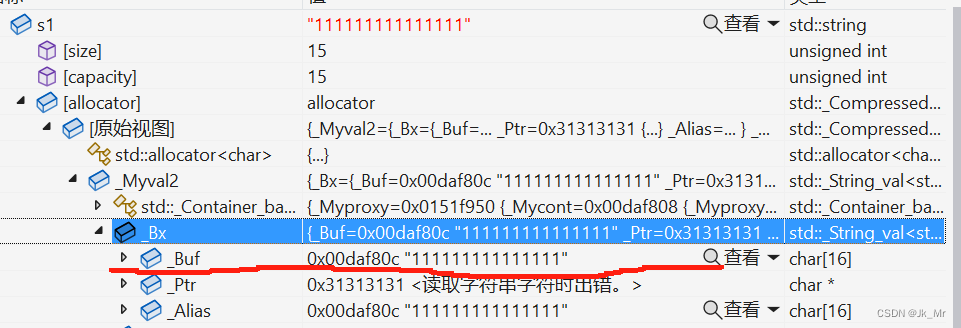
当字符过长时则会在堆空间:
capacity指的是有效数据的空间,所以实际上都会多出一个给'\0'.
linux下的结果:
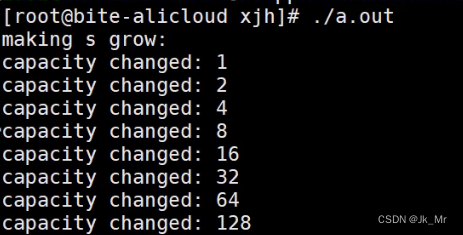
不同的平台扩容是不一样的。但是linux和vs下size和capacity都是指有效空间,实际空间多一个。
9.2 reserve、resize
1 reserve
resize意思是是改变size,实际上也会改变capacity。
reserve则是影响capacity,不会影响size。
string s1;
cout << s1.capacity() << endl;
s1.reserve(100);
cout << s1.capacity() << endl;
说是给100,实际上vs会给多。
而linux则很老实是多少给多少:
接下来看看vs下reserve是否会缩容:
string s1;
cout << s1.capacity() << endl;
s1.reserve(100);
cout << s1.capacity() << endl;
s1.reserve(20);
cout << s1.capacity() << endl;默认不会缩容。
而如果当前有效数据个数小于16,并且缩容到大于有效个数小于16则capacity会变成15.将多余的空间释放掉.
如果有效数据个数大于等于16,则不会发生缩容。
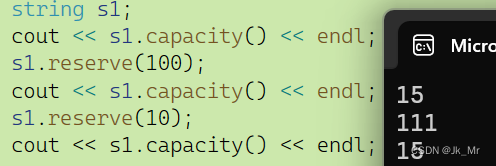
而Linux很听话: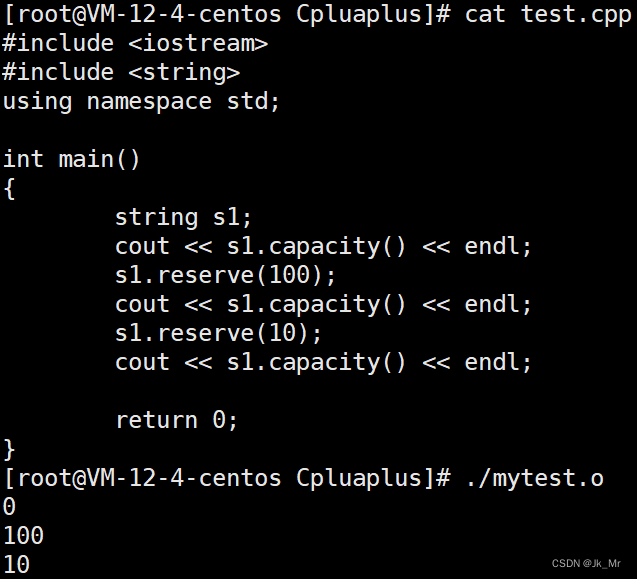
可以知道reserve在未知空间进行扩容可能不确定。
所以reserve使用场景是我们确定要靠多大,提前将空间开辟好:
 后续就不需要扩容了。
后续就不需要扩容了。
如果我们reserve超过有效数据的个数,然后访问我们所reserve的超过有效字节的空间是被允许的吗?
string s1("hello string!");
cout << s1.size() << endl;
cout << s1.capacity() << endl;
s1.reserve(100);
cout << s1.capacity() << endl;
cout << s1[50] << endl;结果是不被允许的,因为operator[]重载时只允许访问有效空间:
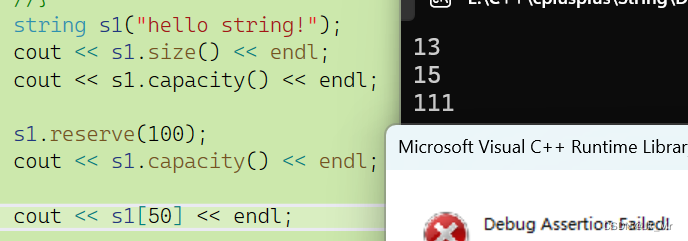
所以缩容一般不用reserve,要使用reserve最好提前知道要开多少空间。
2 resize
如果n小于当前字符串长度,则当前值将缩短为其前n个字符,删除第n个字符之后的字符。
如果n大于当前字符串长度,则当前内容将被扩展,插入到末尾的字符数将达到n。如果指定了c,则新元素将初始化为c的副本,否则它们将是值初始化的字符(空字符\0)。

vs下缩容:
string s1("hello world! and hello vs! and hello string!");
cout << s1 << endl;
cout << s1.size() << endl;
cout << s1.capacity() << endl;
s1.resize(12);
cout << s1 << endl;
cout << s1.size() << endl;
cout << s1.capacity() << endl;扩容:已有的不会动。
string s1("hello world!");
cout << s1 << endl;
cout << s1.size() << endl;
cout << s1.capacity() << endl;
s1.resize(20,'!');
cout << s1 << endl;
cout << s1.size() << endl;
cout << s1.capacity() << endl;注意resize缩容c++并未规定,不同平台缩容结果可能不同。所以缩容我们一般也不用resize。
3 shrink_to_fit

缩容一般用这个。
注意:空间追加和释放都不能分段追加和释放。
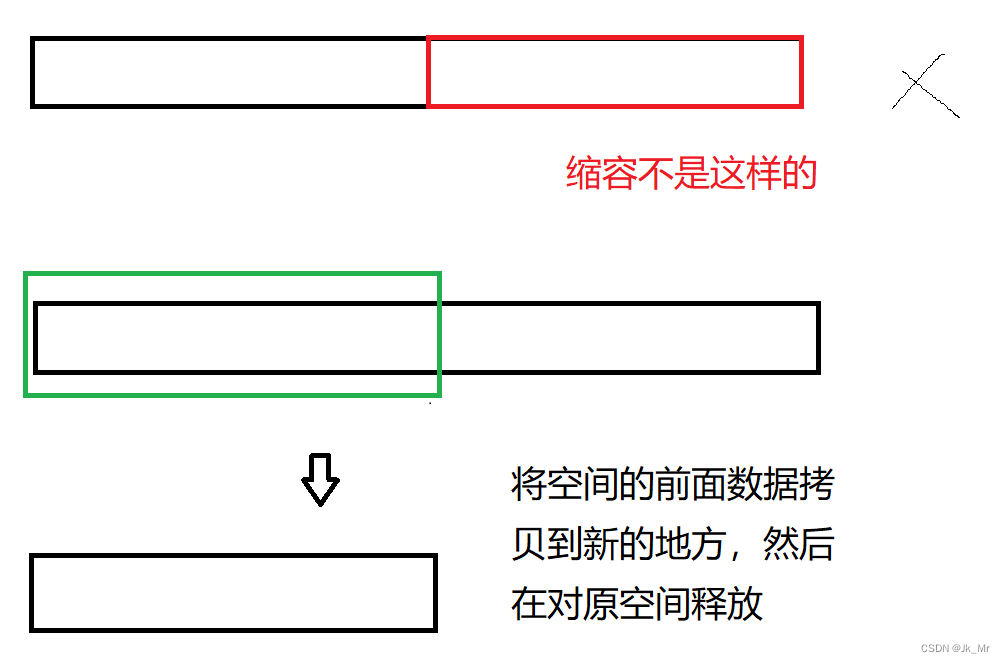
10. 字符串操作
10.1 c_str
为了兼容c语言,对c语言的字符串操作进行使用,c++提供了c_str来获取字符串内容。(不可修改)
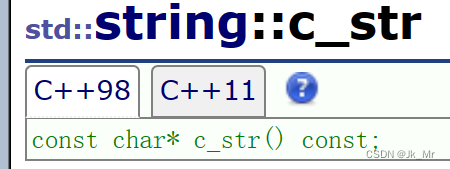
返回一个指针,指向一个包含以空字符结尾的字符序列的数组(即一个 C 字符串),该字符序列表示字符串对象的当前值。
例如在读取文件时:
#define _CRT_SECURE_NO_WARNINGS 1
#include <iostream>
#include <string>
using namespace std;
void test_string()
{
string file("test.cpp");
FILE* fout = fopen(file.c_str(), "r");
char ch = fgetc(fout);
while (ch != EOF)
{
cout << ch;
ch = fgetc(fout);
}
}
int main()
{
test_string();
}10.2 find
find是查找,从前往后找。
与之相对的还有rfind是从后往前找。

用法观察函数的参数就可以知道。
rfind的应用:
获取file的后缀:
string file("test.cpp");
size_t pos = file.rfind('.');
//string suffix(file.substr(pos))
string suffix(file.substr(pos, file.size() - pos));
cout << suffix << endl;substr是获取子串:

取出域名:
string url("https://blog.csdn.net/Jk_Mr");
//找冒号:
size_t pos1 = url.find(':');
string url1 = url.substr(0, pos1 - 0);
cout << url1 << endl;
//找第三个斜杠
size_t pos2 = url.find('/',pos1 + 3);
string url2 = url.substr(pos1 + 3, pos2 - (pos1 + 3));
cout << url2 << endl;
//去到最后
string url3 = url.substr(pos2 + 1);
cout << url3 << endl;10.3 find_first_of
字面上的意思是找到第一个字符,实际上它是找any匹配的字符;从前往后找。

// string::find_first_of
#include <iostream> // std::cout
#include <string> // std::string
#include <cstddef> // std::size_t
int main ()
{
std::string str ("Please, replace the vowels in this sentence by asterisks.");
std::size_t found = str.find_first_of("aeiou");
while (found!=std::string::npos)
{
str[found]='*';
found=str.find_first_of("aeiou",found+1);
}
std::cout << str << '\n';
return 0;
}
从代码结果可以看出,它是找到与参数任意一个匹配的位置。返回值是第一个匹配值的位置,即第一个e。这和c语言中的strtok函数类似。
10.4 find_last_of
从后往前找任何一个相匹配的字符,返回第一个相匹配的字符。

可用于匹配路径Linux和windows:
void SplitFilename(const std::string& str)
{
std::cout << "Splitting: " << str << '\n';
std::size_t found = str.find_last_of("/\\");
std::cout << " path: " << str.substr(0, found) << '\n';
std::cout << " file: " << str.substr(found + 1) << '\n';
}
int main()
{
std::string str1("/usr/bin/man");
std::string str2("c:\\windows\\winhelp.exe");
cout << str2 << endl;
SplitFilename(str1);
SplitFilename(str2);
return 0;
}10.5 find_not_first_of和find_not_last_of
跟find_first_of和find_last_of相反,是和参数都不匹配的。
10.6 compare

11.非成员函数
11.1 operator+
为什么要重载成全局函数?
string s1("hello");
string s2("world!");
//这样可以重载成成员函数
string s3 = s1 + s2;
//但是为了支持第一个参数不是隐藏指针this
//所以重载成成员函数
string s4 = "hello " + s2;为了支持第一个参数不是隐藏指针this,所以重载成成员函数。
11.2 relational operator
同样要支持第一个参数不是this指针,重载成全局函数。
是按照字典序比较的,从第一个开始,如果相同比较下一个的ASCII码值。不相同就返回。
注意:和流提取、流插入的优先级,需要加括号。
实际上设计的有点冗余,因为const char* 可以隐式类型转换到const string&。
12.字符串和其他数组类型转换
c语言中有atoi和itoa用于字符串转换整形和整形转换字符串。C++也有类似的接口: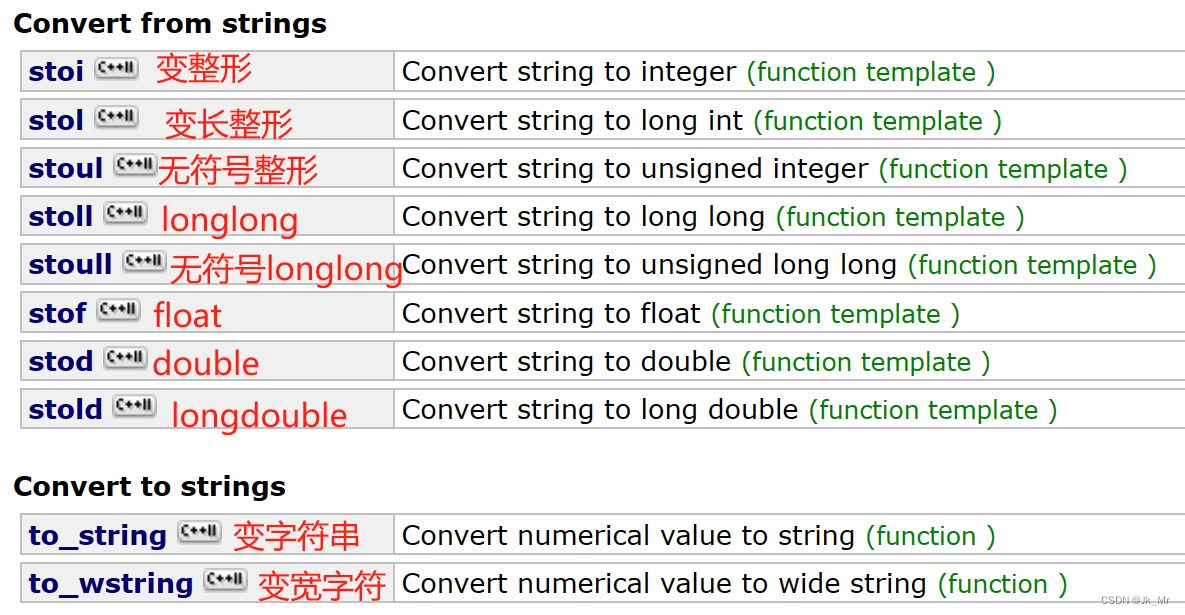
to_string:
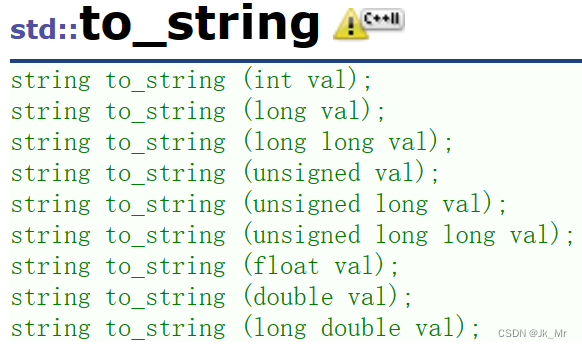
三、字符串题目:
1.仅仅反转字母
917. 仅仅反转字母 - 力扣(LeetCode)![]() https://leetcode.cn/problems/reverse-only-letters/description/
https://leetcode.cn/problems/reverse-only-letters/description/
给你一个字符串
s,根据下述规则反转字符串:
- 所有非英文字母保留在原有位置。
- 所有英文字母(小写或大写)位置反转。
返回反转后的
s。
忽略非字母即可,判断是否为字母,是字母就进行反转:
class Solution {
public:
bool IsAlpha(char s)
{
if(s >='a' && s<= 'z')
return true;
if(s >= 'A' && s <= 'Z')
return true;
return false;
}
string reverseOnlyLetters(string s) {
if(s.empty())
return s;
int begin = 0 , end = s.size()-1;
while(begin < end)
{
//左边边找字符
while(begin < end && !IsAlpha(s[begin]))
{
++begin;
}
//左边边找到了,右边找字符
while(begin < end && !IsAlpha(s[end]))
{
--end;
}
//右边找到了,交换
swap(s[begin],s[end]);
++begin;
--end;
}
return s;
}
};2.字符串中的第一个唯一字符
387. 字符串中的第一个唯一字符 - 力扣(LeetCode)![]() https://leetcode.cn/problems/first-unique-character-in-a-string/description/使用计数排序思想:
https://leetcode.cn/problems/first-unique-character-in-a-string/description/使用计数排序思想:
class Solution {
public:
int firstUniqChar(string s)
{
//范围小可以使用计数排序,统计每个字母出现的次数
//然后返回出现一次的字母
int count[26] = {0};
for(auto ch : s)
{
count[ch -'a']++;//和a的相对位置,a就是下标0位置
}
//s中的每一个字符已经映射到了数组count上,出现一次的被记录,或者没有会出现一次的
//遍历数组查看每个字符的出现次数
for(size_t i = 0 ; i < s.size(); i++)
{
if(count[s[i] - 'a'] == 1)//每个字符相对'a'的差值就是数组count映射的位置
{
return i;
}
}
return -1;
}
};正反查找:
class Solution {
public:
int firstUniqChar(string s)
{
//从首字符开始查找,正查找和逆查找的位置相同则说明该字符只出现了一次
//若不相同则说明有俩个或俩个以上的字符。
for(int i=0; i<s.size(); ++i)
{
int index = s.find(s[i]);
int reverse_index = s.rfind(s[i]);
if(index == reverse_index)
return i;
}
return -1;
}
};3.验证回文串
125. 验证回文串 - 力扣(LeetCode)![]() https://leetcode.cn/problems/valid-palindrome/逆置比较:
https://leetcode.cn/problems/valid-palindrome/逆置比较:
class Solution {
public:
//判断并转换大写为小写
bool IsAlphaOrDigit(char& s)
{
if(s >= 'a' && s<= 'z')
return true;
if(s >= 'A' && s <= 'Z')
{
s += 32;
return true;
}
if(s >= '0' && s<= '9')
return true;
return false;
}
bool isPalindrome(string s) {
string str;//将s逆置放入str,去掉非字母数字字符,大写变小写
int end = s.size() - 1;
for(int i = end; i >= 0; i--)
{
if(IsAlphaOrDigit(s[i]))
{
str += s[i];//尾插
}
}
string com(str);//逆置比较
reverse(com.begin(),com.end());
return com == str;
}
};
//时间:O(N) 空间:O(N)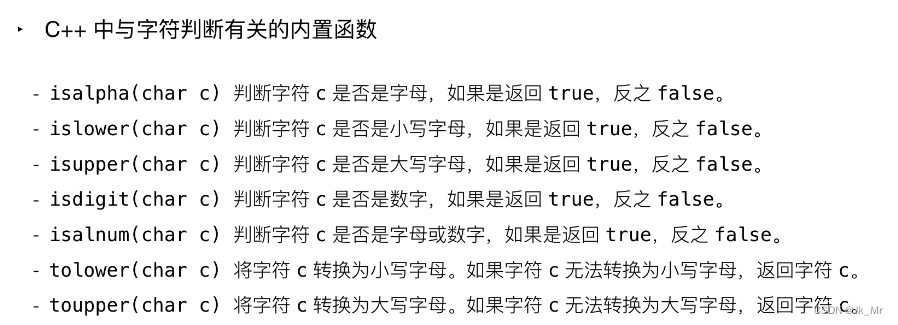
可以使用tolower来进行转换。
双指针比较:
class Solution {
public:
bool IsAlphaOrDigit(char& s)
{
if(s >= 'a' && s<= 'z')
return true;
if(s >= 'A' && s <= 'Z')
{
s += 32;//转换大小写
return true;
}
if(s >= '0' && s<= '9')
return true;
return false;
}
bool isPalindrome(string s) {
//双指针法进行判断
int begin = 0, end = s.size() - 1;
while(begin < end)
{
//左侧找到字母或数字//同时转换大小写
while(begin < end && !IsAlphaOrDigit(s[begin]))
begin++;
//右侧找到字母或数字//同时转换大小写
while(begin < end && !IsAlphaOrDigit(s[end]))
end--;
//将左右比较,不相同false
if(s[begin] != s[end])
return false;
else
{
begin++;
end--;
}
}
return true;
}
};
//时间复杂度: O(N) 空间复杂度:O(1)4.字符串相加
415. 字符串相加 - 力扣(LeetCode)![]() https://leetcode.cn/problems/add-strings/
https://leetcode.cn/problems/add-strings/
/*
*思路:
* 1. 先逆置数据
* 2. 数据对应为进行相加
* 3. 最后若有进位,还需尾插数据,最后逆置恢复数据
*/
class Solution
{
public:
string addStrings(string num1, string num2)
{
//逆置解过进行操作
reverse(num1.begin(), num1.end());
reverse(num2.begin(), num2.end());
//num1和num2的下标
int index1 = 0, index2 = 0;
int carry = 0;//进位标致
int res = 0;//转换数字保存量
string ret;
//循环进行相加,先考虑俩个数字的长度相同
while (index1 < num1.size() || index2 < num2.size() || carry != 0)//若还有进位需要进位
{
//当进位不为0时index1和index2会超过字符串范围
//所以需要判断,然后向前补carry的值res = 0 + 0 + 1;
//有了这一步那么也保证了长短不一:因为超过长度会补0
int x = index1 < num1.size() ? num1[index1] - '0' : 0;
int y = index2 < num2.size() ? num2[index2] - '0' : 0;
//单个相加
res = x + y + carry;
if (res >= 10)
{
carry = 1;
ret += res % 10 + '0';
}
else
{
carry = 0;
ret += res + '0';
}
index1++;
index2++;
}
//将结果在反过来
reverse(ret.begin(), ret.end());
return ret;
}
};
class Solution
{
public:
string addStrings(string num1, string num2)
{
//num1和num2的下标
int index1 = num1.size() - 1, index2 = num2.size() - 1;
int carry = 0;//进位标致
int res = 0;//转换数字保存量
string ret;
//循环进行相加,先考虑俩个数字的长度相同
while (index1 >= 0 || index2 >= 0 )//若还有进位需要进位
{
//当进位不为0时index1和index2会超过字符串范围
//有了这一步那么也保证了长短不一:因为超过长度会补0
int x = index1 >= 0 ? num1[index1--] - '0' : 0;
int y = index2 >= 0 ? num2[index2--] - '0' : 0;
//单个相加
res = x + y + carry;
//处理进位
carry = res /10;
res = res % 10;
//头插//每次都要挪动数据,所以建议尾插然后逆置
//ret.insert(0,1,res + '0');
ret += res + '0';
}
//进位标志不为0
if(carry != 0)
{
ret += res + '0';
}
reverse(ret.begin(),ret.end());
return ret;
}
};5.字符串最后一个单词的长度
字符串最后一个单词的长度![]() https://www.nowcoder.com/practice/8c949ea5f36f422594b306a2300315da?tpId=37&tqId=21224&ru=/exam/oj cin输入:
https://www.nowcoder.com/practice/8c949ea5f36f422594b306a2300315da?tpId=37&tqId=21224&ru=/exam/oj cin输入:
#include <iostream>
#include <string>
using namespace std;
int main() {
string s;
cin >> s;
int pos = s.rfind(" "), last = s.size() - 1;
cout<< last - pos;
return 0;
}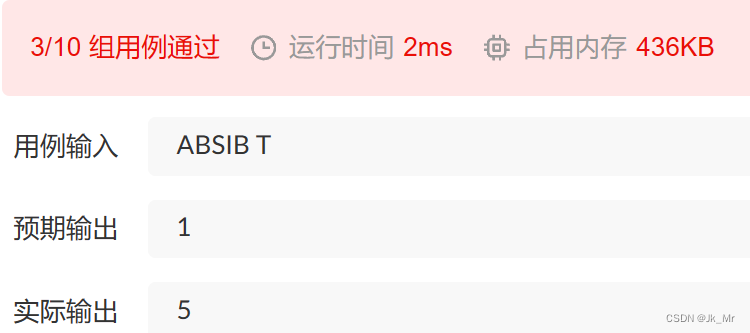
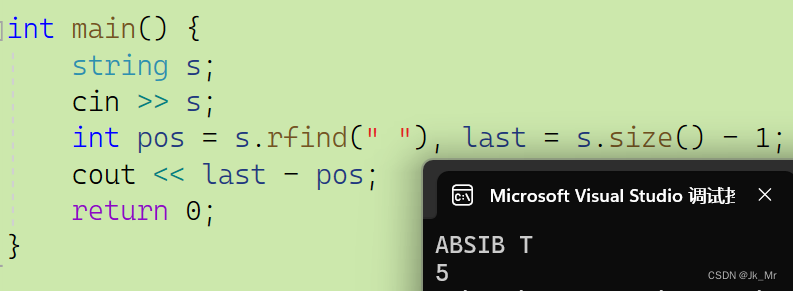
为通过,vs上也是5,这说明cin出了问题。通过vs调试可以看出

cin遇到空格和换行就会结束提取,scanf(除了%c遇到空格不停)也是一样。
c++有一个专门的函数解决:
6.getline

getline默认是遇到换行才停止。
#include <iostream>
#include <string>
using namespace std;
int main() {
string s;
getline(cin,s);
int pos = s.rfind(" "), last = s.size() - 1;
cout<< last - pos;
return 0;
}所以c++中要获取字符串包含空格时,使用getline。
在使用while(cin >> s)时,结束可以用ctrl + C或者 ctrl + Z + 换行。
四、字符排序sort
如果要对一个字符串进行排序该怎么排,由于string中没有专门的排序,所以我们给出下面的排序头文件,在STL中有一个头文件包含算法:
![]() https://legacy.cplusplus.com/reference/algorithm/
https://legacy.cplusplus.com/reference/algorithm/
在这个头文件中:

sort是用于排序的,它是一个模板:
它的范围规定为必须是左闭右开的:

last为无效的位置。迭代器就可以适配这个范围。
string s1("hello string!");
cout << s1 << endl;
//s1 按照字典序排序
sort(s1.begin(), s1.end());
cout << s1 << endl;
部分排序:







